Emergency Response Division
Thousands of incidents occur each year in which oil or chemicals are released into the environment as a result of accidents or natural disasters. Spills into our coastal waters and inland waterways, whether accidental or intentional, can harm people, the environment and the economies on which we rely, causing substantial disruption of marine transportation with potential widespread economic impacts.
The Emergency Response Division (ERD) of NOAA's Office of Response and Restoration (OR&R) provides scientific expertise to support an incident response. Under the National Contingency Plan, NOAA has responsibility for providing scientific support to the federal on-scene coordinator (FOSC) for oil and hazardous material spills. To support this mandate, ERD provides 24-hour a day/seven days a week response to spill events. Find out more about our work with oil and chemical spills.
Response: SSCs and the Seattle Team
When spills occur, NOAA Scientific Support Coordinators (SSCs) coordinate scientific information and provide critical information to the FOSC. A multidisciplinary team of scientists, including oceanographers, modelers, biologists, chemists, and geologists support the SSCs during spill events as well as for drills, exercises, and contingency planning. SSCs are strategically located around the country, often within U.S. Coast Guard (USCG) offices, effectively providing local services to a range of users in public and private sectors. ERD services include:
- Supporting emergency response activities
- Assisting in the development of contingency plans
- Developing tools for local decision makers
- Providing training
ERD facilitates spill prevention, preparedness, and response at national and local levels, and provides expertise on issues such as dispersant use, response countermeasures, and alternative response technologies.
ERD's scope encompasses the entire U.S. coastline, including the Great Lakes, Alaska, Hawaii, and U.S. territories. ERD has responded to virtually every major marine spill in the U.S. In addition, ERD's expertise is frequently sought internationally. While oil and chemical spills are the major focus, ERD also provides support for incidents such as downed aircraft, search and rescue, and tracking floating objects.
The Emergency Response Division typically responds to 150 incidents annually. News, photos, and other information about current and historical spill incidents is available at OR&R's IncidentNews site.
Preparedness
ERD develops tools, guidelines, and small, field-oriented job aids to assist preparedness for response communities. In addition, NOAA provides standard techniques for observing oil, assessing shoreline impact, and evaluating and selecting cleanup technologies that have been widely accepted by response agencies.
Some of ERD's more widely distributed products:
- Environmental Sensitivity Index (ESI) maps and data are used to identify vulnerable resources and habitats in advance of emergencies so that appropriate response actions can be planned. ERD works with local experts to develop or update ESI maps throughout the country. The maps are available for download in a variety of formats.
- The GNOME suite of oil spill response tools estimates the fate and transport of pollutants (such as oil) spilled in water.
- The CAMEO® software suite helps emergency planners and responders deal with chemical incidents. The suite includes a hazard modeling application (ALOHA®), a database of hazardous chemical datasheets with response recommendations and reactivity prediction tool (CAMEO Chemicals), a mapping program (MARPLOT®), and a data management program (CAMEOfm). The suite is developed jointly with the Environmental Protection Agency.
Training
Each year, ERD provides training to approximately 1,000 individuals in industry and government on the scientific aspects of oil and chemical spill response. The goal of ERD training is to transfer scientific expertise and experience to the broadest possible audience. Successful training promotes more efficient planning and spill response.
More Information about ERD
History of oil spill response at NOAA: In the days and weeks following the grounding and spill from the tanker Argo Merchant on December 15, 1976, NOAA began its first major coordinated oil spill response activity.
From the Beginning: The 40 Year History of NOAA’s Emergency Response Division: An International Oil Spill Conference Proceedings (2017) article authored by OR&R staff.
 An official website of the United States government.
An official website of the United States government. 

